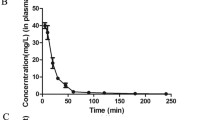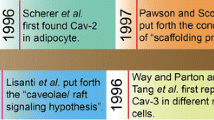Abstract
The demonstration that caveolin-3 overexpression reduces myocardial ischemia/reperfusion injury and our own finding that multiprotein signaling complexes increase in mitochondria in association with caveolin-3 levels, led us to investigate the contribution of caveolae-driven extracellular signal-regulated kinases 1/2 (ERK1/2) on maintaining the function of cardiac mitochondrial subpopulations from reperfused hearts subjected to postconditioning (PostC). Rat hearts were isolated and subjected to ischemia/reperfusion and to PostC. Enhanced cardiac function, reduced infarct size and preserved ultrastructure of cardiomyocytes were associated with increased formation of caveolar structures, augmented levels of caveolin-3 and mitochondrial ERK1/2 activation in PostC hearts in both subsarcolemmal (SSM) and interfibrillar (IFM) subpopulations. Disruption of caveolae with methyl-β-cyclodextrin abolished cardioprotection in PostC hearts and diminished pho-ERK1/2 gold-labeling in both mitochondrial subpopulations in correlation with suppression of resistance to permeability transition pore opening. Also, differences between the mitochondrial subpopulations in the setting of PostC were evaluated. Caveolae disruption with methyl-β-cyclodextrin abolished the cardioprotective effect of postconditioning by inhibiting the interaction of ERK1/2 with mitochondria and promoted decline in mitochondrial function. SSM, which are particularly sensitive to reperfusion damage, take advantage of their location in cardiomyocyte boundary and benefit from the cardioprotective signaling driven by caveolae, avoiding injury propagation.







Similar content being viewed by others
References
Aldakkak M, Stowe DF, Dash RK, Camara AKS (2013) Mitochondrial handling of excess Ca2+ is substrate-dependent with implications for reactive oxygen species generation. Free Radic Biol Med 56:193–203. doi:10.1016/j.freeradbiomed.2012.09.020
Alonso M, Melani M, Converso D, Jaitovich A, Paz C, Carreras MC, Medina JH, Poderoso JJ (2004) Mitochondrial extracellular signal-regulated kinases 1/2 (ERK1/2) are modulated during brain development. J Neurochem 89:248–256. doi:10.1111/j.1471-4159.2004.02323.x
Baines CP, Zhang J, Wang GW, Zheng YT, Xiu JX, Cardwell EM, Bolli R, Ping P (2002) Mitochondrial PKCepsilon and MAPK form signaling modules in the murine heart: enhanced mitochondrial PKCepsilon-MAPK interactions and differential MAPK activation in PKCepsilon-induced cardioprotection. Circ Res 90:390–397. doi:10.1161/01.RES.0000069215.36389.8D
Boengler K, Stahlhofen S, Sand A, Gres P, Ruiz-Meana M, Garcia-Dorado D, Heusch G, Schulz R (2009) Presence of connexin 43 in subsarcolemmal, but not in interfibrillar cardiomyocyte mitochondria. Basic Res Cardiol 104:141–147. doi:10.1007/s00395-009-0007-5
Chang G, Zhang D, Yu H, Zhang P, Wang Y, Zheng A, Qin S (2013) Cardioprotective effects of exenatide against oxidative stress-induced injury. Int J Mol Med 32:1011–1020. doi:10.3892/ijmm.2013.1475
Chávez E, Briones R, Michel B, Bravo C, Jay D (1985) Evidence for the involvement of dithiol groups in mitochondrial calcium transport: studies with cadmium. Arch Biochem Biophys 242:493–497. doi:10.1016/0003-9861(85)90235-8
Chen Q, Ross T, Hu Y, Lesnefsky EJ (2012) Blockade of electron transport at the onset of reperfusion decreases cardiac injury in aged hearts by protecting the inner mitochondrial membrane. J Aging Res 2012:753949. doi:10.1155/2012/753949
Correa F, García N, Gallardo-Pérez J, Carreño-Fuentes L, Rodríguez-Enríquez S, Marín-Hernández A, Zazueta C (2008) Post-conditioning preserves glycolytic ATP during early reperfusion: a survival mechanism for the reperfused heart. Cell Physiol Biochem 22:635–644. doi:10.1159/000185547
Correa F, García N, Robles C, Martínez-Abundis E, Zazueta C (2008) Relationship between oxidative stress and mitochondrial function in the post-conditioned heart. J Bioenerg Biomembr 40:599–606. doi:10.1007/s10863-008-9186-2
Correa F, Zazueta C (2005) Mitochondrial glycosidic residues contribute to the interaction between ruthenium amine complexes and the calcium uniporter. Mol Cell Biochem 272:55–62. doi:10.1007/s11010-005-6754-1
Kalogeris T, Baines CP, Krenz M, Korthuis RJ (2012) Cell biology of ischemia/reperfusion injury. Int Rev Cell Mol Biol 298:229–317. doi:10.1016/B978-0-12-394309-5.00006-7
Duarte A, Castillo AF, Podestá EJ, Poderoso C (2014) Mitochondrial fusion and ERK activity regulate steroidogenic acute regulatory protein localization in mitochondria. PLoS One 9:e100387. doi:10.1371/journal.pone.0100387
Fernandez-Gomez FJ, Galindo MF, Gomez-Lazaro M, González-García C, Cẽna V, Aguirre N, Jordán J (2005) Involvement of mitochondrial potential and calcium buffering capacity in minocycline cytoprotective actions. Neuroscience 133:959–967. doi:10.1016/j.neuroscience.2005.03.019
Folino A, Sprio AE, Di Scipio F, Berta GN, Rastaldo R (2015) Alpha-linolenic acid protects against cardiac injury and remodelling induced by beta-adrenergic overstimulation. Food Funct 6:2231–2239. doi:10.1039/c5fo00034c
Fridolfsson HN, Kawaraguchi Y, Ali SS, Panneerselvam M, Niesman IR, Finley JC, Kellerhals SE, Migita MY, Okada H, Moreno AL, Jennings M, Kidd MW, Bonds JA, Balijepalli RC, Ross RS, Patel PM, Miyanohara A, Chen Q, Lesnefsky EJ, Head BP, Roth DM, Insel PA, Patel HH (2012) Mitochondria-localized caveolin in adaptation to cellular stress and injury. FASEB J 26:4637–4649. doi:10.1096/fj.12-215798
Galli S, Jahn O, Hitt R, Hesse D, Opitz L, Plessmann U, Urlaub H, Poderoso JJ, Jares-Erijman EA, Jovin TM (2009) A new paradigm for MAPK: structural interactions of hERK1 with mitochondria in HeLa cells 4:7541. doi:10.1371/journal.pone.0007541
García N, Zazueta C, Martínez-Abundis E, Pavón N, Chávez E (2009) Cyclosporin A is unable to inhibit carboxyatractyloside-induced permeability transition in aged mitochondria. Comp Biochem Physiol C Toxicol Pharmacol 149:374–381. doi:10.1016/j.cbpc.2008.09.006
García-Niño WR, Tapia E, Zazueta C, Zatarain-Barrón ZL, Hernández-Pando R, Vega-García CC, Pedraza-Chaverrí J (2013) Curcumin pretreatment prevents potassium dichromate-induced hepatotoxicity, oxidative stress, decreased respiratory complex I activity, and membrane permeability transition pore opening. Evid Based Complement Altern Med 2013:424692. doi:10.1155/2013/424692
Graziani A, Bricko V, Carmignani M, Graier WF, Groschner K (2004) Cholesterol- and caveolin-rich membrane domains are essential for phospholipase A 2-dependent EDHF formation. Cardiovasc Res 64:234–242. doi:10.1016/j.cardiores.2004.06.026
Hernández-Reséndiz S, Roldán FJ, Correa F, Martínez-Abundis E, Osorio-Valencia G, Ruíz-De-Jesús O, Alexánderson-Rosas E, Vigueras RM, Franco M, Zazueta C (2013) Postconditioning protects against reperfusion injury in hypertensive dilated cardiomyopathy by activating MEK/ERK1/2 signaling. J Card Fail 19:135–146. doi:10.1016/j.cardfail.2013.01.003
Hernández-Reséndiz S, Zazueta C (2014) PHO-ERK1/2 interaction with mitochondria regulates the permeability transition pore in cardioprotective signaling. Life Sci 108:13–21. doi:10.1016/j.lfs.2014.04.037
Heusch G (2015) Molecular basis of cardioprotection: signal transduction in ischemic pre-, post-, and remote conditioning. Circ Res 116:674–699. doi:10.1161/CIRCRESAHA.116.305348
Horikawa YT, Patel HH, Tsutsumi YM, Jennings MM, Kidd WK, Hagiwara Y, Ishikawa Y, Insel PA, Roth DM (2008) Caveolin-3 expression and caveolae are required for isoflurane-induced cardiac protection from hypoxia and ischemia/reperfusion injury. J Mol Cell Cardiol 44:123–130. doi:10.1016/j.yjmcc.2007.10.003
Kulich SM, Horbinski C, Patel M, Chu CT (2007) 6-hydroxydopamine induces mitochondrial ERK activation. Free Radic Biol Med 43:372–383. doi:10.1016/j.biotechadv.2011.08.021
Kurian GA, Berenshtein E, Saada A, Chevion M (2012) Rat cardiac mitochondrial sub-populations show distinct features of oxidative phosphorylation during ischemia, reperfusion and ischemic preconditioning. Cell Physiol Biochem 30:83–94. doi:10.1159/000339043
Kuznetsov AV, Margreiter R (2009) Heterogeneity of mitochondria and mitochondrial function within cells as another level of mitochondrial complexity. Int J Mol Sci 10:1911–1929. doi:10.3390/ijms10041911
Lesnefsky EJ, Chen Q, Slabe TJ, Stoll MS, Minkler PE, Hassan MO, Tandler Bernard, Hoppel CL (2007) Ischemia, rather than reperfusion, inhibits respiration through cytochrome oxidase in the isolated, perfused rabbit heart: role of cardiolipin. Am J Physiol Heart Circ Physiol 287:H258–H267. doi:10.1152/ajpheart.00348.2003
Lowry O, Rosebrough N, Farr A, Randall R (1951) Protein measurement with the folin phenol reagent. J Biol Chem 193:265–275
Monick MM, Powers LS, Barrett CW, Hinde S, Ashare A, Groskreutz DJ, Nyunoya T, Coleman M, Spitz DR, Hunninghake GW (2008) Constitutive ERK MAPK activity regulates macrophage ATP production and mitochondrial integrity. J Immunol 180:7485–7496. doi:10.4049/jimmunol.180.11.7485
Paillard M, Gomez L, Augeul L, Loufouat J, Lesnefsky EJ, Ovize M (2009) Postconditioning inhibits mPTP opening independent of oxidative phosphorylation and membrane potential. J Mol Cell Cardiol 46:902–909. doi:10.1016/j.yjmcc.2009.02.017
Patel HH, Tsutsumi YM, Head BP, Niesman IR, Jennings M, Horikawa Y, Huang D, Moreno AL, Patel PM, Insel PA, Roth DM (2007) Mechanisms of cardiac protection from ischemia/reperfusion injury: a role for caveolae and caveolin-1. FASEB J 21:1565–1574. doi:10.1096/fj.06-7719com
Penna C, Perrelli MG, Tullio F, Angotti C, Camporeale A, Poli V, Pagliaro P (2013) Diazoxide postconditioning induces mitochondrial protein S-Nitrosylation and a redox-sensitive mitochondrial phosphorylation/translocation of RISK elements: no role for SAFE. Basic Res Cardiol 108:371. doi:10.1007/s00395-013-0371-z
Quinlan CL, Costa ADT, Costa CL, Pierre SV, Dos Santos P, Garlid KD (2008) Conditioning the heart induces formation of signalosomes that interact with mitochondria to open mitoKATP channels. Am J Physiol Heart Circ Physiol 295:H953–H961. doi:10.1152/ajpheart.00520.2008
Ruiz-Meana M, Fernandez-Sanz C, Garcia-Dorado D (2010) The SR-mitochondria interaction: a new player in cardiac pathophysiology. Cardiovasc Res 88:30–39. doi:10.1093/cvr/cvq225
See Hoe LE, Schilling JM, Tarbit E, Kiessling CJ, Busija AR, Niesman IR, Du Toit E, Ashton KJ, Roth DM, Headrick JP, Patel HH, Peart JN (2014) Sarcolemmal cholesterol and caveolin-3 dependence of cardiac function, ischemic tolerance, and opioidergic cardioprotection. Am J Physiol Heart Circ Physiol 307:H895–H903. doi:10.1152/ajpheart.00081.2014
Schilling JM, Horikawa YT, Zemljic-Harpf AE, Vincent KP, Tyan L, Yu JK, McCulloch AD, Balijepalli RC, Patel HH, Roth DM (2016) Electrophysiology and metabolism of caveolin-3-overexpressing mice. Basic Res Cardiol 111:28. doi:10.1007/s00395-016-0542-9
Sun J, Nguyen T, Aponte AM, Menazza S, Kohr MJ, Roth DM, Patel HH, Murphy E, Steenbergen C (2015) Ischemic preconditioning preferentially increases protein S-nitrosylation in subsarcolemmal mitochondria. Cardiovasc Res 106:227–236. doi:10.1093/cvr/cvv044
Tsutsumi YM, Tsutsumi R, Hamaguchi E, Sakai Y, Kasai A, Ishikawa Y, Yokoyama U, Tanaka K (2014) Exendin-4 ameliorates cardiac ischemia/reperfusion injury via caveolae and caveolins-3. Cardiovasc Diabetol 13:132. doi:10.1186/s12933-014-0132-9
Villalta JI, Galli S, Iacaruso MF, Arciuch VGA, Poderoso JJ, Jares-Erijman EA, Pietrasanta LI (2011) New algorithm to determine true colocalization in combination with image restoration and time-lapse confocal microscopy to map Kinases in mitochondria. PLoS One 6:e19031. doi:10.1371/journal.pone.0019031
Wang J, Schilling JM, Niesman IR, Headrick JP, Finley JC, Kwan E, Patel PM, Head BP, Roth DM, Yue Y, Patel HH (2014) Cardioprotective trafficking of caveolin to mitochondria is Gi-protein dependent. Anesthesiology 121:538–548. doi:10.1097/ALN.0000000000000295
Wortzel I, Seger R (2011) The ERK cascade: distinct functions within various subcellular organelles. Genes Cancer 2:195–209. doi:10.1177/1947601911407328
Yang Y, Ma Z, Hu W, Wang D, Jiang S, Fan C, Di S, Sun Y (2016) Yi W (2016) Caveolin-1/-3: therapeutic targets for myocardial ischemia/reperfusion injury. Basic Res Cardiol 111:45. doi:10.1007/s00395-016-0561-6
Yu H, Yang Z, Pan S, Yang Y, Tian J, Wang L, Sun W (2015) Hypoxic preconditioning promotes the translocation of protein kinase C ε binding with caveolin-3 at cell membrane not mitochondrial in rat heart. Cell Cycle 14:3557–3565. doi:10.1080/15384101.2015.1084446
Zhu J-H, Guo F, Shelburne J, Watkins S, Chu CT (2003) Localization of phosphorylated ERK/MAP kinases to mitochondria and autophagosomes in Lewy body diseases. Brain Pathol 13:473–481. doi:10.1016/j.bbi.2008.05.010
Zhuang S, Kinsey GR, Yan Y, Han J, Schnellmann RG (2008) Extracellular signal-regulated kinase activation mediates mitochondrial dysfunction and necrosis induced by hydrogen peroxide in renal proximal tubular cells. J Pharmacol Exp Ther 325:732–740. doi:10.1124/jpet.108.136358
Acknowledgements
The authors thank Rocio Torrico-Lavayen for technical assistance.
Author information
Authors and Affiliations
Corresponding authors
Ethics declarations
Conflict of interest
The authors declare that they have no conflict of interest.
Ethical standard
All authors in this work gave their informed consent prior to their inclusion in the study. The manuscript does not contain clinical studies or patient data.
Funding
This work was supported by Grant 177527 to CZ, 181593 to FC and 220046 to JP-Ch from the National Council of Science and Technology (CONACYT), Mexico.
Electronic supplementary material
Below is the link to the electronic supplementary material.
Rights and permissions
About this article
Cite this article
García-Niño, W.R., Correa, F., Rodríguez-Barrena, J.I. et al. Cardioprotective kinase signaling to subsarcolemmal and interfibrillar mitochondria is mediated by caveolar structures. Basic Res Cardiol 112, 15 (2017). https://doi.org/10.1007/s00395-017-0607-4
Received:
Accepted:
Published:
DOI: https://doi.org/10.1007/s00395-017-0607-4




